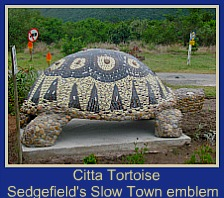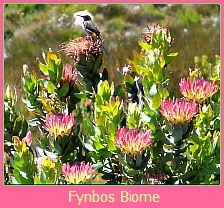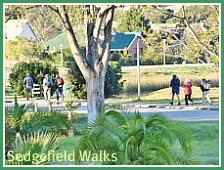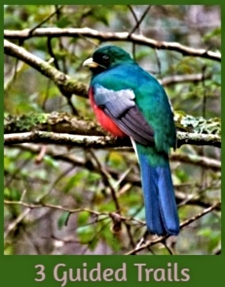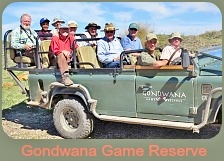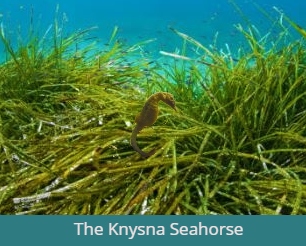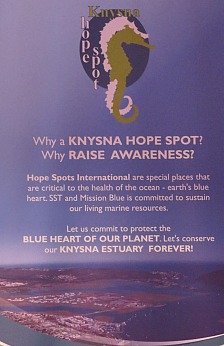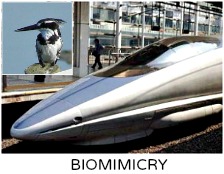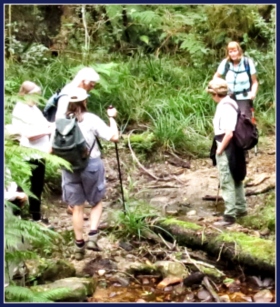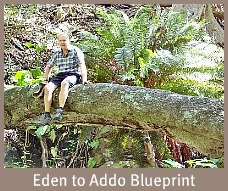Fynbos Creatures
Once upon a time, fynbos creatures comprised large animals such as elephant, black rhino, hippo, buffalo, eland, leopard and lion freely roaming all areas of the Western Cape. Less than a century later all but a few antelope had disappeared, hunted to the last one by the early settlers. They live on only in national parks or game farms.
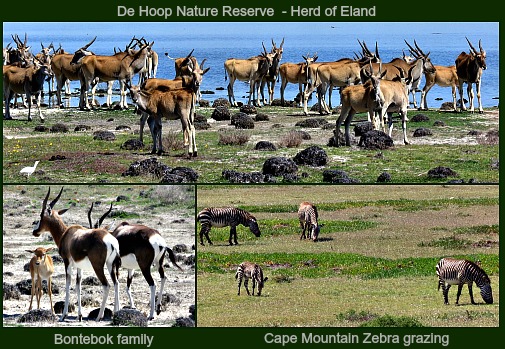
The Bontebok was rescued from extinction when there were less than 100 left and similarly the Cape Mountain Zebra. Blue Antelope are extinct - wiped out for good!
Fortunately humanity has come to realise that these creatures interact with their environment in a necessary and beneficial way. Nothing exists in a vacuum.
As we have mostly been detrimental to our environment, with knowledge comes the ability to change and in most situations to make amends, as nature has proved repeatedly to be very forgiving.
Restoration of large Fynbos Creatures
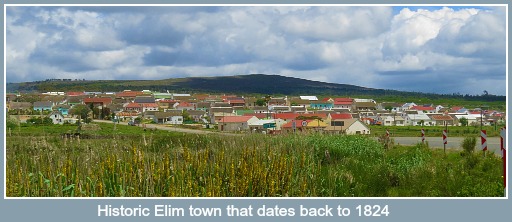
To that end, conservation bodies like SANParks and Cape Nature in partnership with private individuals, companies, landowners and oversea contributors are working together on diverse projects to restore our damaged and diminished natural fynbos environment.
One such project, the first of its kind in South Africa, is the Nuwejaars Special Management Area within a hotspot of biodiversity on the Agulhas Plain. It currently involves 25 land-owners working together with local communities to manage 46000 hectares of badly degraded and critically threatened lowland wetland. Buffalo, hippo, eland, red hartebeest, bontebok, quagga and mountain zebra are fynbos creatures that have been reintroduced to the landscape.
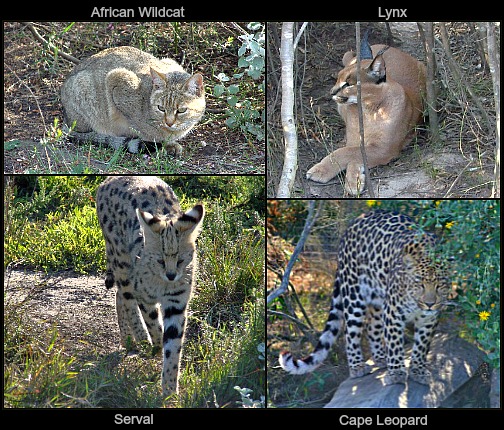
Employing and training locals for various projects, such as clearing 3000 hectares of alien vegetation, fire management and wildlife infrastructure is giving 300 people jobs improving their lives and those of their families. Further opportunities range from sustainable harvesting of fynbos to training hiking-birding-wildlife-fynbos identifying guides and cultural tours.
The historic Elim community is part and parcel of the Wetland restoration project. The ultimate aim is to sustainably manage the wetland for the lasting benefit and enjoyment of all who live there and those who visit it.
Other projects like the Eden to Addo Biosphere and closer to home, the Garden Route Biosphere (pending), are also underway tackling the same issues in different ways. Their aim is to provide corridors through which our fynbos creatures can safely migrate to and fro from fragmented areas to find better food sources or to mate, or to find new territory when the need arises.
Buy-in from private landowners and local communities is critical to the success of these projects. Education and understanding as to why they are essential creates the motivation.
“Not everything that counts can be counted and not everything that can be counted, counts.” – William Bruce Cameron
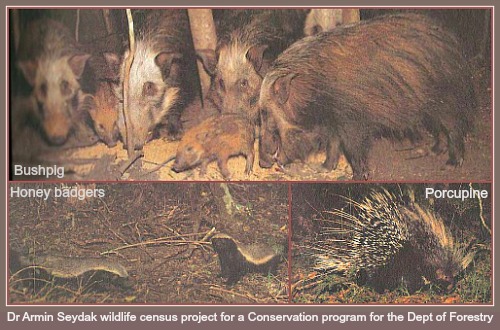
Even the abhorrent and shameful story of the decimated herds of elephant, that sought protection in remote parts of the Knysna forests yet continued to be persecuted until a mere 12 were left, could still end happily. Until recently it was thought that only one named the Matriarch remained keeping to the forest depths and seldom seen.
However, an independent researcher, Gareth Patterson has discovered through DNA testing of elephant droppings that there are at least 5 females in the Knysna forest, a young male has been photographed and evidence found on occasion of an older one in musth.
It seems possible that without human interference or protection a small herd could be recovering from the brink of extinction. How amazing is that! These could be the last and only free-roaming elephants in South Africa.

Smaller secretive creatures and those with solitary or nocturnal habits have survived better - porcupines, honey badgers, antbears, genets, lynx, mongooses fall into this category but can fall victim to poisoned bait set out by farmers for jackals as do birds of prey like the stunning Verreaux's Eagle and magnificent Cape Vulture. Sadly, these creatures are also often caught in illegal traps set by poachers.
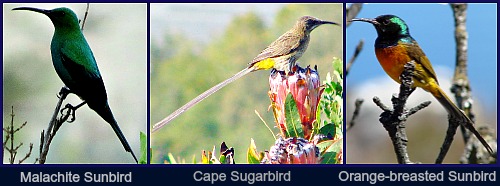
Baboons and monkeys are remarkably adaptable but often come into conflict with human settlements. It is costing Cape Town Muncipality in excess of R10 million annually to monitor the 11 baboon troops on the Cape Peninsula and to institute methods that minimise the conflict between humans and these wild fynbos creatures.
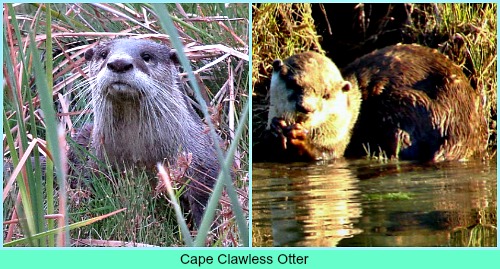
Shrews, snakes, dassies, moles, molerats, dormice, rats and gerbils all contribute in some way to fynbos life as do many bird species amongst them, Protea canaries, Cape Sugarbirds, Orange-breasted sunbirds, Cape Rockjumpers and Victorin's Warblers that are endemic to this biome.
Cape Clawless Otters are secretive and endearing creatures, entertaining to watch, found throughout South Africa wherever fresh water environments can support them and are fairly common along the Garden Route where rivers and vleis are plentiful.
Indigenous means –present in an area purely through natural processes i.e. without human intervention but because it’s adapted to local conditions. It means that birds and wildlife in the same area, can make use of it, might even depend on it. It is now appreciated that our natural environment is highly complex where everything, however inconspicuous it may appear to us, has a vital contribution to make. For example,
The Brenton Blue
“There is nothing in a caterpillar that tells you its going to be a butterfly." Buckminster Fuller
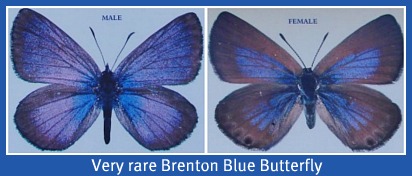
One of the fynbos creatures, the Brenton Blue Butterfly is restricted to a very small area in the midst of a residential suburb of Knysna. It occurs only on a 2 hectare patch of south facing slopes at Brenton–on-Sea. Fortunately a reserve has been proclaimed over this piece of ground in an attempt to protect this vulnerable butterfly. (This is just 25kms from Sedgefield!)
The female lays her eggs on the leaves of one very specific plant of the pea family, the indigofera erecta of the fynbos biome. The larvae are tended and protected by a particular species of ant, C. baynei. Therefore the survival of this butterfly depends on these other two elements being able to survive.
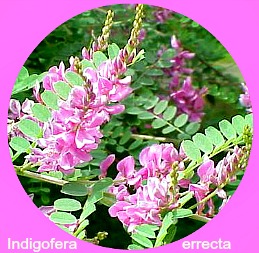
The butterfly itself can be seen from late October to December and
again from February to March, the periods when it appears to be most active.
So when we don’t understand the role of “indigenous”, we don’t value it and we risk losing it. A break in the environmental chain can have a domino effect that threatens the survival of something else that depends on it and then another link is broken in the chain for further dependents down the line.
The role of apex predators such as lion and leopard have been realised to be of vital importance in controlling lesser predators like jackal that are now considered vermin but nonetheless have a part to play in the natural environment keeping lesser creatures like rats and mice in check.
Ignorance has resulted in many valuable contributors to the environment like aardvarks, bat-eared foxes, brown hyenas and wild dogs being relentlessly and needlessly persecuted by the farming community. All these animals were once fynbos creatures.
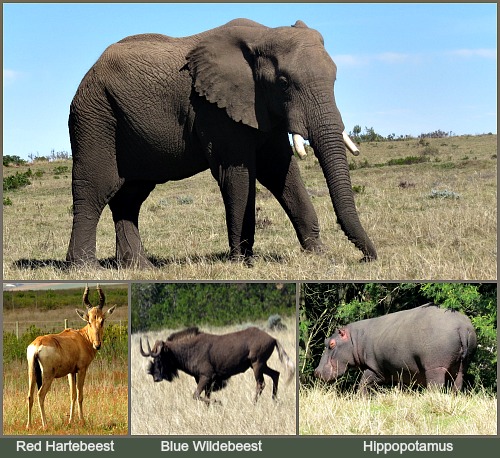
So seeing Fynbos creatures when driving, cycling or walking in the countryside is a thrilling experience. All aspects of nature, its scent, its colours and its forms are appealing.
The attraction of many birds, butterflies, bees and insects, snakes as well as small mammals like grysbok, mongooses, dassies, bush-buck, striped mice and tortoises reflect its vitality.
With so much exhuberant life in the fynbos biome, let's consciously do what we can to promote it and protect it. It's to be hoped that we’ll live to see the larger animals playing their part in our wilderness fynbos areas, once again.
When we open our hearts to appreciate nature's awesome magnificence we find a desire within us to be considerate and compassionate towards all sentient beings. We can allow ourselves to become aware and find within ourselves a deep appreciation for the earth’s generosity reflected in abundant diverse life-forms.
We are part and parcel of this unique and precious planet we call home and by living in harmony with our natural environment we reap great health benefits physically, mentally, emotionally and spiritually, we cannot experience through any other means.

